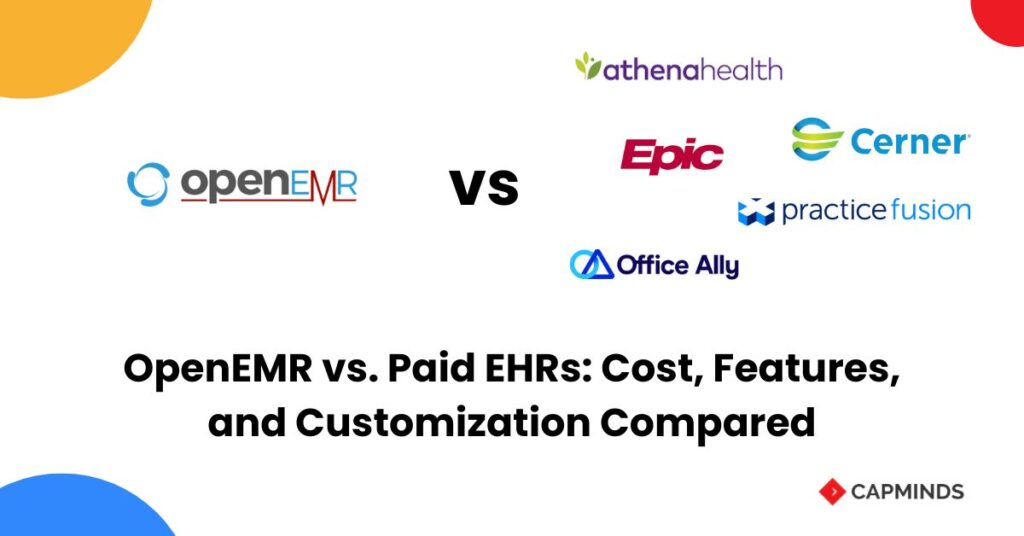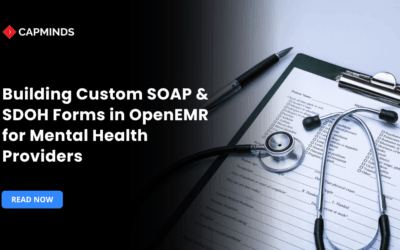OpenEMR vs. Paid EHRs: Cost, Features, and Customization Compared
Choosing the appropriate EHR system is one of the most important and costly decisions for a healthcare organization. Clinics and hospitals are overwhelmed by the quantity of options, each promising smooth processes, reducing administrative load, and improved patient care.
Sales pitches can lead to excessive subscription rates, inflexible procedures, or hidden fees that can affect small practices. Many suppliers are stuck with proprietary systems that do not adapt to their changing demands.
OpenEMR is an open-source EHR software noted for its flexibility and no license fees. In this blog, we’ll compare OpenEMR and Paid EHRs, focusing on pricing, features, customization, support, and scalability to help practices make an informed decision.
Comparison Between OpenEMR vs Paid EHR
1. Cost Comparison
OpenEMR – OpenEMR licenses cost $0 as it is an open-source under the GNU General Public License. Self-hosted or third-party starting at $5-$100 per month for VPS. Customization for in-house or third-party developer (once or continuing). Long-term ownership, as the cost is low, particularly for firms with technological skills.
Paid EHR – Some of the paid EHRs are Athenahealth, Kareo, and NextGen. License costs range from $300 to $1,000+ per provider/month. Implementation costs from $1,000 to $10,000 for onboarding, training, and setup. Customization is limited and expensive. Recurring expenditures are high, particularly when you expand.
OpenEMR outperforms on cost. OpenEMR’s low cost can be a game changer for startups, community clinics, and international non-governmental organizations.
2. Features and Functionality
Both OpenEMR and Paid EHR offer the following core clinical features.
- Patient Charting
- E-prescribing
- Appointment and scheduling
- Billing and Claims
- Lab integration
- Patient Portal
OpenEMR – OpenEMR includes clinical decision support, CQM reporting, remote monitoring, and telehealth. ONC Certified supports Meaningful Use compliance in the United States. Global support is used in over 100 countries, with multilingual assistance. Modular Design has extensive modules for reporting, referrals, eRx, and other features.
Paid EHR – Commercial EHRs frequently invest in user-friendly interfaces and usability. Premium EHRs, like Epic, include AI-predictive analytics, NLP-based charting, and ML. Integrated system includes RCM, patient engagement systems, and care coordination platforms.
Paid EHRs may have a competitive advantage in sophisticated analytics and user experience, but OpenEMR provides solid basic functionalities for free.
3. Customization and Flexibility
OpenEMR – OpenEMR is open-source code and provides complete access to the source code for adjustments. Highly customizable, allowing modification process, adding modules, and integrations like FHIR, HL7. Users can customize the interface and logic to reflect location, particularly for specialized clinics.
Paid EHRs – Paid EHRs provide limited customization options for workflows and user interfaces. Customization frequently necessitates submitting tickets and paying extra costs. Paid EHR has a proprietary codebase where users cannot manage the program; everything operates under the vendor’s terms.
OpenEMR is ideal in terms of flexibility. It’s perfect for tech-savvy practices or those with internal IT staff.
Related: OpenEMR vs Cerner: The Ultimate Comparison
4. Compliance and Security
OpenEMR – OpenEMR is HIPAA-compliant when properly hosted. ONC certification guarantees adherence to US federal rules. Security is dependent on how well the deployment is managed, like updates, encryption, and backups must be proactively maintained. Multi-factor authentication is supported using third-party plugins.
Paid EHRs – Paid EHRs offer end-to-end security and managed hosting, SOC2 compliance, and 24/7 monitoring. Data is backed up, encrypted, and protected by disaster recovery systems. Systems automatically update, and users don’t have to worry about patches or vulnerabilities.
Paid EHRs provide superior turnkey security, but OpenEMR can compete with a professional setup.
5. Support and Community
OpenEMR – OpenEMR offers community-driven support through active forums, documentation, and GitHub updates. Several organizations provide paid support, cloud hosting, and development. Select your assistance partner or go completely in-house.
Paid EHR – Dedicated support teams to handle email, chat, and phone assistance with SLAs. Training and onboarding involve hands-on instruction, certification, and setup assistance. In-person support for big practices, providers offer on-site support and integration advice.
Paid EHRs offer more immediate assistance. OpenEMR requires technical expertise or a reliable vendor.
6. Interoperability
OpenEMR – OpenEMR supports FHIR, HL7, and X12. Community modules provide compatibility with modern data standards. Third-party APIs facilitate connectivity with laboratories, pharmacies, imaging facilities, and health applications. Customizable data flow where users can decide how and where data should go.
Paid EHRs- Paid EHRs provide built-in interoperability tools for seamless data transmission between hospitals, laboratories, and payers. Carequality/CommonWell Networks automatically link to national health data networks. Referral management improves communication across platforms.
Paid EHRs provide greater plug-and-play interoperability, while OpenEMR provides complete control over data integration with the proper configuration.
Use Cases of OpenEMR vs Paid EHR
|
Criteria |
OpenEMR |
Paid EHR |
| Small Practice | Affordable and customizable | Can be cost-prohibitive |
| Clinics with IT Teams | Full control, ideal for tech-led setups | Limited Flexibility |
| Enterprise Hospitals | Needs more support and effort | Full-suite enterprise support |
| Global Clinics | Multilingual and adaptable | U.S.-centric features, higher pricing |
| Rapid Scale-Up | Add users anytime at no cost | Costs grow with each user/module |
OpenEMR and paid EHRs each have significant advantages. While paid EHRs provide hands-free comfort, elegant design, and first-rate support, OpenEMR offers unparalleled flexibility, cost, and developer freedom.
For clinics prepared to spend on early setup or collaborate with an experienced support partner, OpenEMR may match or even outperform commercial EHR capabilities at a fraction of the cost.
Related: Cut EHR Licensing Costs by 60%: OpenEMR vs. Legacy Systems for Enterprise-Scale Operations
CapMinds OpenEMR Customization and Integration Service
CapMinds OpenEMR equips clinicians with the best features and ways to integrate. It makes their workflows more efficient and filtered.
The integrated features will allow them to combine the ability of patient record management with conceptual and concurrent reminders.
This enhances the process of decision-making and improves patient care and quality.
- At CapMinds, OpenEMR custom solutions are developed with much care and accuracy to match the special practice needs.
- It will be low-cost and the perfect budget solution for your practice’s long-term future.
- CapMinds OpenEMR prioritizes secure data management & ensures compliance with industry regulations, offering healthcare providers peace of mind.
Get the best technologies and HIPAA-compliant and efficient OpenEMR from CapMinds that can be tailored to fit your practice.
Our OpenEMR services facilitate a Modern User Interface (UI), customization, production support, and training. They also facilitate billing, reporting, specialty enhancements, clearing house integrations, e-prescribing, and cloud services.
“Get the most experienced, proven, and perfect professional support for your OpenEMR.”




